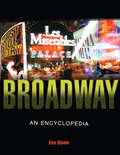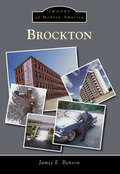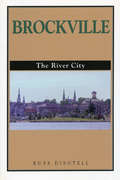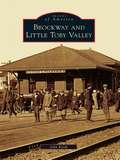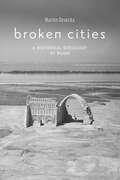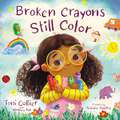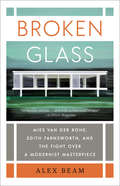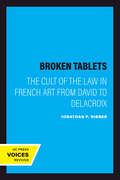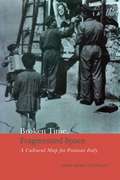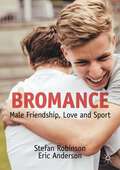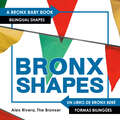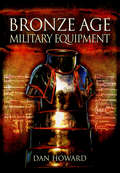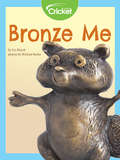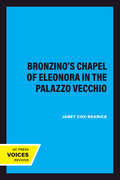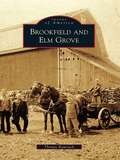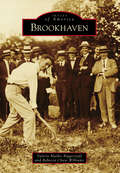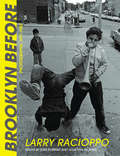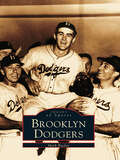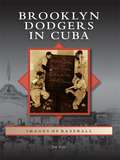- Table View
- List View
Broadway: An Encyclopedia
by Ken BloomThis volume is another example in the Routledge tradition of producing high-quality reference works on theater, music, and the arts. An A to Z encyclopedia of Broadway, this volume includes tons of information, including producers, writer, composers, lyricists, set designers, theaters, performers, and landmarks in its sweep.
Brockton: The 1941 Brockton Tragedy And The Fallen Thirteen (Images of Modern America)
by James E. BensonBrockton, first settled in 1700, was originally a part of Old Bridgewater, known as North Parish and later as North Bridgewater. On April 9, 1881, it officially became the City of Brockton. During the Civil War, Brockton was the largest producer of shoes in the country, earning it the nickname "Shoe City." As a growing industrial center, Brockton had the proud honor of being first in the world and nation in many ways. On October 1, 1883, the city became the first in the world to have a three-wire underground electrical system, initially turned on by Thomas Edison. In 1884, the Central Fire Station became the first electrically operated fire station in the country. In 1894, the City Theater had the distinction of being the first in the world tied to a three-wire underground system. In 1890, Col. James Edgar, owner of Edgar's Department Store, donned a Santa Claus outfit, becoming the first department store likeness of the jolly old man. Brockton is also known as the "City of Champions," being the hometown of boxing greats Rocky Marciano and Marvelous Marvin Hagler.
Brockville: The River City
by Russ DisotellBrockville’s origins reach back to the resettlement of Loyalists following the American Revolution and the threat of American encroachment. Following the War of 1812, Brockville, along the St. Lawrence River, benefitted greatly from the rapidly expanding colonization. A centre for the political activity of the day and a focal point for the Orange movement, Brockville was often immersed in controversy.The end of the 19th century was the golden age of patent medicine business and Brockville was home to two of the most successful, the W. H. Comstock Company and the G. T. Fulford Company. "Pink Pills for Pale People" were sold worldwide. Today, Brockville retains the charm of its heritage mansions and is home to a number of prominent industries.
Brockway and Little Toby Valley
by John KeithBrockway, originally called Brockwayville until the name was shortened in 1925, is named after the Brockway family pioneers who settled near the southern bend of Little Toby Creek in 1822. The Brockways were followed by several other settlers, including the "Father of Brockway," Dr. Asaph M. Clarke, who laid out the town in 1836. Farming and lumbering were the original industries, but by 1883, coal mining had brought in the railroads. Railroads introduced more industry, the most famous being the Brockwayville Machine Bottle Company in 1907. Through images from the Brockway Area Historical Society, Brockway and Little Toby Valley chronicles the development of this industrious community.
Broken Boxes: A Decade of Art, Action, and Dialogue
by Ginger Dunnill Josie LopezBroken Boxes: A Decade of Art, Action, and Dialogue celebrates ten years of Ginger Dunnill’s podcast of the same name and exalts the intersectionality of contemporary artists. Intersectionality studies the overlapping and intersecting social identities and related systems of oppression, domination, and discrimination. Here are twenty-three extraordinary artists bringing the creativity of their processes and identities to life in the Albuquerque Museum’s exhibition and in this accompanying book. Broken Boxes delves deeply into the realm of intentionality, challenging not just how artists create, but why. And Broken Boxes—the podcast, the exhibition, and the book—thrives on bringing artists together in dialogue with each other through the artist’s own words. This book provides an opportunity to introduce the larger public to artists committed to creating, sustaining, and encouraging solidarity. By opening up the conversations across communities, groups, art practices, materials, and shared space, we hope to demonstrate how artists are forging new forms of action.
Broken Cities: A Historical Sociology of Ruins
by Martin DeveckaA comparative study of cities that fell into ruin through human involvement.We have been taught to think of ruins as historical artifacts, relegated to the past by a catastrophic event. Instead, Martin Devecka argues that we should see them as processes taking place over a long present. In Broken Cities, Devecka offers a wide-ranging comparative study of ruination, the process by which monuments, architectural sites, and urban centers decay into ruin over time. Weaving together four case studies—of classical Athens, late antique Rome, medieval Baghdad, and sixteenth-century Mexico City—Devecka shows that ruination is a complex social process largely contingent on changing imperial control rather than the result of immediate or natural events. Drawing on literature, legal texts, epigraphic evidence, and the narratives embodied in monuments and painting, Broken Cities is an expansive and nuanced study that holds great significance for the field of historiography.
Broken Crayons Still Color
by Toni Collier Whitney BakHelp your kids process big feelings, build a social-emotional tool kit, and find beauty in life's challenges with this creative story that expresses the hope of the gospel from podcast host, speaker, and mom Toni Collier.Avery has big emotions and bubbling anxieties about changes in her life. When her crayons break as she scribbles furiously, she discovers that they have personalities and feelings too! And they can show her how to use her love of coloring to manage scary, overwhelming feelings and embrace curiosity and joy. As Avery follows the crayons' advice, gets creative, and chooses bravery and positive thinking, she discovers that God can use her to make beautiful things, even with broken crayons.In Broken Crayons Still Color, children 4 to 8 willsee that everyone feels frustrated and overwhelmed at timeslearn to express emotions and explore creativitypractice coping skills, such as drawing worries, affirmations, and breathingunderstand that God loves them just as they are and He can turn their mistakes and weaknesses into beautiful new thingsThis illustrated picture book includesan inventive illustration style that models to children how to draw their own feelingsan emotion color chart to guide children in identifying how they feelWith a fun story, silly crayon characters, and practical guidance for kids struggling with powerful emotions, insecurity, and perfectionism, Broken Crayons Still Color will entertain children as it assures them that God is making a beautiful masterpiece out of things they thought were broken. The presentation page and deluxe dust jacket make this encouraging book a beautiful gift for back-to-school, kids facing new experiences and tough situations, and any child with big feelings.
Broken Glass: Mies van der Rohe, Edith Farnsworth, and the Fight Over a Modernist Masterpiece
by Alex BeamThe true story of the intimate relationship that gave birth to the Farnsworth House, a masterpiece of twentieth-century architecture—and disintegrated into a bitter feud over love, money, gender, and the very nature of art.&“An amazing story, brilliantly told.&”—Sebastian Smee, Pulitzer Prize–winning art critic and author of The Art of Rivalry In 1945, Edith Farnsworth asked the German architect Mies van der Rohe, already renowned for his avant-garde buildings, to design a weekend home for her outside of Chicago. Edith was a woman ahead of her time—unmarried, she was a distinguished medical researcher, as well as an accomplished violinist, translator, and poet. The two quickly began spending weekends together, talking philosophy, Catholic mysticism, and, of course, architecture over wine-soaked picnic lunches. Their personal and professional collaboration would produce the Farnsworth House, one of the most important works of architecture of all time, a blindingly original structure made up almost entirely of glass and steel.But the minimalist marvel, built in 1951, was plagued by cost overruns and a sudden chilling of the two friends' mutual affection. Though the building became world famous, Edith found it impossible to live in, because of its constant leaks, flooding, and complete lack of privacy. Alienated and aggrieved, she lent her name to a public campaign against Mies, cheered on by Frank Lloyd Wright. Mies, in turn, sued her for unpaid monies. The ensuing lengthy trial heard evidence of purported incompetence by an acclaimed architect, and allegations of psychological cruelty and emotional trauma. A commercial dispute litigated in a rural Illinois courthouse became a trial of modernist art and architecture itself.Interweaving personal drama and cultural history, Alex Beam presents a stylish, enthralling narrative tapestry, illuminating the fascinating history behind one of the twentieth-century's most beautiful and significant architectural projects.
Broken Idols of the English Reformation
by Margaret AstonWhy were so many religious images and objects broken and damaged in the course of the Reformation? Margaret Aston's magisterial new book charts the conflicting imperatives of destruction and rebuilding throughout the English Reformation from the desecration of images, rails and screens to bells, organs and stained glass windows. She explores the motivations of those who smashed images of the crucifixion in stained glass windows and who pulled down crosses and defaced symbols of the Trinity. She shows that destruction was part of a methodology of religious revolution designed to change people as well as places and to forge in the long term new generations of new believers. Beyond blanked walls and whited windows were beliefs and minds impregnated by new modes of religious learning. Idol-breaking with its emphasis on the treacheries of images fundamentally transformed not only Anglican ways of worship but also of seeing, hearing and remembering.
Broken Mirrors/Broken Minds: The Dark Dreams of Dario Argento
by Maitland McDonaghItalian filmmaker Dario Argento’s horror films have been described as a blend of Alfred Hitchcock and George Romero—psychologically rich, colorful, and at times garish, excelling at taking the best elements of the splatter and exploitation genres and laying them over a dark undercurrent of human emotions and psyches. Broken Mirrors/Broken Minds, which dissects such Argento cult films as Two Evil Eyes, The Bird with the Crystal Plumage, Suspiria, and Deep Red, includes a new introduction discussing Argento’s most recent films, from The Stendahl Syndrome to Mother of Tears; an updated filmography; and an interview with Argento.
Broken Tablets: The Cult of the Law in French Art from David to Delacroix
by Jonathan P. RibnerIn this first study of art, law, and the legislator, Jonathan Ribner provides a revealing look at French art from 1789 to 1848, the period in which constitutional law was established in France. Drawing on several disciplines, he discusses how each of the early constitutional regimes in France used imagery suggesting the divine origin and sacred character of its laws. Primarily a study of art and politics, Broken Tablets discusses painting, sculpture, prints, and medals (many reproduced here for the first time), as well as contemporary literature, including the poetry of Alfred de Vigny, Alphonse de Lamartine, and Victor Hugo. Ribner assesses the ways in which legislation imagery became an instrument of political propaganda, and he clearly illuminates the cult of the law as it became personalized under Napoleon, monarchist under the Restoration, and defensive under Louis-Phillipe.
Broken Time, Fragmented Space: A Cultural Map of Postwar Italy (The Royal Society of Canada Special Publications)
by Anna Maria TorrigliaBroken Time, Fragmented Space: A Cultural Map for Post-war Italy examines how the artists and intellectuals of post-war Italy dealt with the 'shameful' heritage of their fascist upbringing and education by trying to craft a new cultural identity for themselves and the country. The continuities between the culture of the fascist and post-fascist periods were, however, far greater than what intellectuals were ready to admit, creating an uncomfortable, sometimes schizophrenic relation to time, as a painful urge to erase the past.Drawing on a variety of critical approaches, Torriglia investigates the efforts to reconstruct a personal as well as a collective self by analyzing both canonical and lesser-known cinematic and literary texts. Organized around four main themes - the use of language, the interaction between personal and public spheres, the perceptual categories of history and memory, and the reconstruction of the female identity - the study also includes historical introductions and sociological commentary that provides an extensive and captivating picture of the cultural production in 1950s Italy, a period that has not yet been extensively studied.
Bromance: Male Friendship, Love and Sport
by Eric Anderson Stefan RobinsonUnraveling the stereotype that men’s friendships are unemotional and shallow, this book provides the first detailed account of the bromance that exists among young men. Drawing on one year of ethnography and 20 in-depth interviews among a university sport team, the authors show that these men reject traditional masculine boundaries, instead prioritizing an emotional and tactile form of friendship. Chapters detail the cultural shift in society’s views on bromances, showing that bromances exists as an elevated, more emotional and intimate form of friendship, existing as a further positive consequence of decreasing cultural homophobia. By focusing on sport—which has traditionally been seen as a homophobic environment with toxic constructions of manhood—the authors show that even in the most traditionally masculine of settings, young men are rethinking what male friendship looks like, what it means to be a man, and the positive impact this can have on their mental health. This book will be relevant to a number of audiences including scholars and students in masculinity studies, queer studies, and friendship studies; LGBTQ+ activists and allies with interest in straight men’s friendships and sports cultures; and men’s mental health advocates.
Bronx Tales
by Constance RosenblumIn these vignettes of life along the Grand Concourse in the Bronx, the New York Times's Constance Rosenblum examines the place of art in this community-- its installation, its reception by local residents, and the debates that often surround it. From the growing popularity of European-style Art Deco in the 1930s and '40s, to the opinion of some Bronx residents that these modern additions were "ugly as hell," and from public art criticized for controversial content to buildings revered for their innovative design, the reception of art and architecture along the Concourse serves as a way to explore the role, function, and place of art in urban spaces.
Bronxshapes (Bronx Baby)
by Alex RiveraA new bilingual board book that introduces the youngest of readers to the SHAPES of the Bronx!Take a walk through the Bronx and what do you see? CIRCLE wheels on a classic tricycle, a vast DIAMOND where the Yankees play baseball, colorful TRIANGLE flags above the bodega, and more! Bronxshapes, the second board book in a new series, teaches young readers about shapes through Bronx native Alex Rivera's eye-catching photographs and creative design. The small square trim (7" x 7") and sturdy pages are a perfect format for toddlers, and the content inside promotes language acquisition and concept learning in both English and Spanish. Curl up with your little one for a bilingual story time that helps them reach important developmental milestones.
Bronxtones (Bronx Baby)
by Alex RiveraA new bilingual board book that introduces the youngest of readers to the COLORS of the Bronx!Where can you find your best friend playing with a RED balloon, tamales from your favorite GREEN cart, or YELLOW pineapple raspados? The Bronx! Bronxtones, the first board book in a new series, teaches young readers about colors through the vibrant palette of the Bronx, as captured by Bronx native Alex Rivera's eye-catching photographs and creative design. The small square trim (7" x 7") and sturdy pages are a perfect format for toddlers, and the content inside promotes language acquisition and concept learning in both English and Spanish. Curl up with your little one for a bilingual story time that helps them reach important developmental milestones.
Bronze Age Military Equipment
by Dan Howard&“A very valuable piece of work, providing a splendid overview&” of the weapons, armor, shields and chariots used in warfare from 3000 BC to 1200 BC (HistoryOfWar.org). This book is a fascinating discussion of the development of the military equipment of the earliest organized armies. Dan Howard describes the development of weapons, armor and chariots, how they were made and their tactical use in battle. Spanning from the introduction of massed infantry by the Sumerians (c. 26th century BC) through to the collapse of the chariot civilizations (c. 12th century BC), this is the period of the epic struggles described in the Old Testament and Homer&’s Iliad, the clashes of mighty empires like those of the Babylonians, Egyptians and Hittites. In Bronze Age Military Equipment, Howard provides &“an able and readable review that is supported in the text by drawings and sketches, but there is also an excellent full color photographic section that shows replica weapons and armor created in bronze&” (Firetrench).
Bronze Me
by Liz HuyckHave you ever wondered how bronze statues are made? Bronze is a type of metal, which can be made into different forms when heated at high temperatures. Bronze can be poured into a mold to create a statue. It takes years to master the art of making bronze statues; it includes a five-step process. Learn more about making bronze statues!
Bronze Screen: Chicana and Chicano Film Culture
by Rosa Linda FregosoExplores Chicana and Chicano popular culture through contemporary representations in both Hollywood commercial and independent cinema.Rosa Linda Fregoso&’s The Bronze Screen opens the way for international debate on the new critical field of Chicano/a cinema. Fregoso provides an incisive articulation of the ways in which narrative codes in film can telescope complex versions of Mexican and American culture and history. The often violent impact of &‘first&’ (U.S.) and &‘third&’ (Mexico) world cultures and geographies is channeled through the very term Chicano/a as well as its cinematic representation. Fregoso&’s masterful critique brings out with great clarity the irony, paradox, and contradictions of such historical collisions. --Norma Alarcón, University of California, Berkeley
Bronzino's Chapel of Eleonora in the Palazzo Vecchio (California Studies in the History of Art #29)
by Janet Cox-RearickDo the sacred decorations of a Florentine Renaissance chapel—saints, symbols, and scriptural stories—hold personal and political meanings? Cox-Rearick's ground-breaking book explores the message hidden in the frescoes and altar panels of the Chapel of Eleonora di Toledo, painted in the early 1540s by Agnolo Bronzino for the Spanish-born wife of Duke Cosimo I de Medici. Bronzino, then the chief painter to the Medici court, was largely responsible for the invention in Florence of the highly self-conscious, elegant Maniera style. Cox-Rearick interweaves her account of the Medici biography with an examination of Bronzino's commission in the broader context of his oeuvre.Cox-Rearick reveals the Chapel of Eleonora as an intimately devised decorative program that transmits messages about its patrons and Medici rule. Detailed color photographs of the newly restored art splendidly document this early tour de force of a major artist whose works are still relatively unexamined.
Brookfield and Elm Grove
by Tom RamstackThe old town of Brookfield provides an ethnic microcosm of what makes Wisconsin's settlement story so unique. As Native Americans, primarily the Potawatomi tribe, were forced out of the region, in came large numbers of Protestant farmers from New York State. A step and a half behind the New Yorkers came distinct colonies of families from western Europe--Catholics from near Nuremberg, Bavaria; Evangelical Lutherans from Canton Bern, Switzerland; Methodists from Lincolnshire, England; Zion Evangelicals from Sulzback, Württemberg; as well as Catholics from County Sligo, Ireland.
Brookhaven (Images of America)
by Valerie Mathis Biggerstaff Rebecca Chase WilliamsBrookhaven has long benefited from its prime location. With two creeks running through it and the well-traveled thoroughfare that became Peachtree Road, Brookhaven was a familiar place to Native Americans, Civil War soldiers, and early settlers like the Goodwin family, whose home became a railroad stop. Adjacent to the city of Atlanta, Brookhaven grew into a community of gracious neighborhoods, parks, and lakes and became home to Oglethorpe University. In 2013, Brookhaven became a city, and it continues to benefit and grow as businesses and families are attracted by its proximity to Atlanta.
Brooklyn Before: Photographs, 1971–1983
by Larry RacioppoBefore Brooklyn rose to international fame there existed a vibrant borough of neighborhoods rich with connections and traditions. During the 1970s and 1980s, photographer Larry Racioppo, a South Brooklynite with roots three generations deep, recorded Brooklyn on the cusp of being the trendy borough we know today.In Brooklyn Before Racioppo lets us see the vitality of his native Brooklyn, stretching from historic Park Slope to the beginnings of Windsor Terrace and Sunset Park. His black and white photographs pull us deep into the community, stretching our memories back more than forty years and teasing out the long-lost recollections of life on the streets and in apartment homes. Racioppo has the fascinating ability to tell a story in one photograph and, because of his native bona fides, he depicts an intriguing set of true Brooklyn stories from the inside, in ways that an outsider simply cannot. On the pages of, Brooklyn Before the intimacy and roughness of life in a working-class community of Irish American, Italian American, and Puerto Rican families is shown with honesty and insight.Racioppo’s 128 photographs are paired with essays from journalist Tom Robbins and art critic and curator Julia Van Haaften. Taken together, the images and words of Brooklyn Before return us to pre-gentrification Brooklyn and immerse us in a community defined by work, family, and ethnic ties.
Brooklyn Dodgers (Images of Sports)
by Mark RuckerIf there was ever a place in America where a city and its baseball team were as close as family, it was Brooklyn. The legacy of this relationship comes down to us in stories of childhoods spent at Ebbets Field and in the stories of Jackie Robinson and Branch Rickey, whose courage changed the face of America. Baseball in Brooklyn goes back to the beginning of the sport, when a young city embraced a new game and, like missionaries, carried it to the nation. This book tells the story of that beginning and concludes with the heart-wrenching move of the franchise to the West Coast after the 1957 season. Brooklyn Dodgers carries us from the birth of baseball in the streets of Brooklyn through the decades in Flatbush when Ebbets Field was the center of the Brooklyn community. That was a time when the players lived in the neighborhoods not far from the ballpark, side by side with their followers. Duke Snider, Pee Wee Reese, Jackie Robinson, Gil Hodges, and Johnny Podres all make appearances in this exciting selection of photographs. A large part of Brooklyn Dodgers is dedicated to those teams of the 1950s and their irrepressible fans.
Brooklyn Dodgers in Cuba (Images of Baseball)
by Jim VittiThe Brooklyn Dodgers held spring training in Havana in 1947 so Jackie Robinson could practice safely. <P><P>Yet that was hardly the beginning: the Bums played in Cuba over 60 seasons, from 1900 to 1959. Ballplayers drank hard with Hemingway. Some found themselves in Cuban jails. Pitcher Van Lingle Mungo, barricaded in the Hotel Nacional with two women, fended off an angry husband (and his machete). Leo Durocher got into a brawl with an umpire, after Lippy's translator correctly cursed him in Spanish. Vin Scully watched machine gun-toting barbudas enter the room. An outfielder leaped into the stands, with a loaded gun, to chase a fan. <P><P>Several players encountered Castro, who once walked onto the field in his fatigues, patted his pistol, and said to Lefty Locklin, "Tonight, we win."
